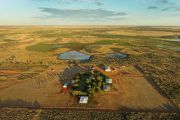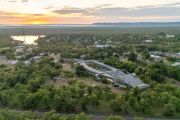
Is 2025 the inflection point for the office market?
The office market is at an inflection point, with modest price rises possible this year for the nation’s best CBD towers, according to experts polled by The Australian Financial Review.
That forecast comes after two years of heavy going in the sector, as high interest rates and bond yields forced valuation writedowns while business uncertainty and flexible working trends weakened demand for space.
Major landlords have been writing down the valuations of their portfolios while some prominent CBD buildings along the east coast have traded at discounts of as much as 30 per cent to their peak value.

But all that could be changing finally, with green shoots likely to emerge first in Sydney’s core financial district, according to respondents in the Financial Review’s latest quarterly property survey.
“The office market could see stabilisation or modest recovery [in 2025], particularly for premium, energy-efficient buildings in prime locations, but not across all markets,” said Benjamin Martin-Henry, MSCI’s regional head of real assets research.
“Demand for high-quality assets, combined with potential easing of interest rates, may support values in these segments as businesses seek well-located, modern workspaces.”
Sydney had bottomed out – as the Perth and Brisbane markets had already done – but Melbourne’s gap between valuation yields and transaction yields indicated that market had further to fall, Mr Martin-Henry said.
“Challenges remain for secondary-grade assets, with high vacancy rates and persistent work-from-home trends continuing to weigh on valuations as tenants seek to take advantage of better deals in prime space and the need for high-quality office space to drive workers back to the office,” he also said.
Signs of improvement
Highlighting just how hard the sector has been hit is Hines’ proposed purchase for $600 million of a North Sydney building from Dexus – which had an $800 million valuation upon completion in 2019. If finalised as expected, the mooted deal would represent a 25 per cent discount.
Yet, that possible deal is also among the last year’s largest in the beaten-down office sector, and an indicator in itself that major investors are gaining confidence that the cycle has bottomed.
Another signal investor sentiment is improving is the tally of office deals in Sydney’s financial core, which rose to about $4 billion last year, a total greater than that of the previous four years combined.
“Office values will start to recover in 2025. However, in the near term the recovery will be confined to the strongest and most liquid markets, most notably Sydney CBD,” said Ben Burston, chief economist at Knight Frank.
“From there, the recovery will broaden to encompass the best-performing assets in North Sydney, Brisbane CBD and Melbourne CBD, before expanding to the market more widely.”
Interest rate cuts would be the “critical determinant” of the strength of economic recovery, Mr Burston said.
“As we move into the recovery phase, performance will be divergent depending on location and asset quality, with many secondary assets and suburban locations likely to remain challenged even as prime CBD assets return to growth,” he said.
While respondents were careful about quantifying the extent of the recovery, the common benchmark for any estimation is the capitalisation rate, or cap rate, applied to commercial property assets.
Akin to an investment yield and loosely correlated to bond yields, a rise in cap rates typically signals falling asset values, and vice versa. Cap rates for prime Sydney office towers rose to just over 6 per cent last year from about 4.4 per cent in early 2022 when office tower values are considered to have peaked.
“We anticipate office cap rates will compress by 100 basis points through the upcoming cycle, with Sydney – particularly the core precinct – the first to observe cap rate tightening in this cycle,” said CBRE chief economist Sameer Chopra.
“For Sydney core, we forecast 50 basis points cap rate tightening during 2025. Brisbane could also respond once interest rates start to move lower.
“Melbourne yield tightening is likely to be a bit more delayed due to elevated vacancy, Perth, Adelaide and Canberra to tighten between 90-100 basis points from late 2025 through to late 2027.”
Rental growth
Analyst Lou Pirenc, Jarden’s head of property and REITs, is taking a more cautious outlook on the cap rate, which he says is close to a peak in expansion.
Looking further ahead, Jarden is assuming another 20 basis points in expansion over the six months to December 2025 followed by another 15-basis-point rise through to June in 2026 when cap rates will stabilise.
The other critical factor is rental growth. That is running at about 5 per cent at face value, although that is offset by incentives – such as rent-free periods or sponsored office fit-outs – which are around 45-48 per cent of rents charged, according to Mr Pirenc.
“Those assets highly sought after and well occupied will probably see incentives stable, while less desirable assets will require further maintenance and incentive capex to attract tenants, placing downward pressure on future cash flows,” he said.
That is a view endorsed by Maree Kilroy, Oxford Economics Australia’s senior economist for construction and property forecasting, who estimates office values are at or close to their trough.
“Over the next 12 months, our view is for minimal growth, underpinned by increases in stated rents, propped up by high incentives,” she said.
As the recent run of Sydney deals shows, the most immediate determinant of value will be the depth of investor interest.
That appetite will only be encouraged by the anticipated rate cuts this year which will, in turn, make the risk premium for office assets look “comparatively attractive”, according to Luke Dixon, RW Capital’s head of institutional capital and research.
“What may delay the rise in prices is the sustained weak demand profile of the sector: double-digit vacancy rates persist, work from home is becoming more prolonged and increasing government debt may result in public service cuts which would weaken absorption in most markets,” he said.
“Based on anecdotal evidence from super funds, and offshore groups I talk to, many of them are gearing up to enter the office market in 2025.
“Sydney, Brisbane, Perth and Canberra are my picks for the best markets to see strong performance in 2025, Melbourne will continue to lag due to its tax regime and very weak demand profile linked to a worsening economic outlook.”











